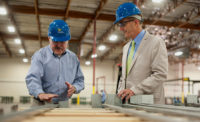A Conversation with Louis and Dennis Astorino
 |  |
| Louis Astorino | Dennis Astorino |
 |
| UPMC Children’s Hospital of Pittsburgh |
Louis D. Astorino, who is chairman of the company, founded L.D. Astorino Cos. in 1972. Its second employee was Dennis Astorino, his brother and the company’s chief executive. ENR Correspondent Jonathan Barnes recently spoke with them.
ENR: How was Astorino started?
L.A.: I was always blessed with the ability to sketch. I rented a space and did renderings of buildings for other architects. That really helped me.
ENR: How would you characterize the growth of the company?
D.A.: It’s been a very slow, methodical growth. My employee number is number two. The company’s growth was more about the kind of projects that interested us. Our size is a product of our doing the projects that we always wanted to do.
ENR: Astorino Architects has a long work relationship with the Pittsburgh Catholic Diocese, having done its first job on a historic Pittsburgh church. Astorino’s most famous work is likely the chapel that the company designed recently for the Vatican. How’d you get that job?
L.A.: The company landed the highly prestigious Chapel of the Holy Spirit job in the Vatican through a connection with Pittsburgh businessman John E. Connelly. He introduced us to the top officials and that allowed us to present our credentials. We did some early work as a consultant to Vatican architects on Domus Santa Marta, which is a Residence hotel where the Cardinals are housed during a Conclave… As a result of that, we were asked to do the Chapel of the Holy Spirit as the sole architects.
ENR: Does Astorino have a signature design?
L.A.: We really don’t believe in a signature style. Each project is influenced by so many factors—site, program, client, context, etc. We believe in keeping an open mind and letting those factors influence our design.
ENR: How did your company become a health care facility design expert?
L.A.: Twelve years ago we bought a firm that did mostly health care related work. Health care work now comprises 60% of our work. We’re dedicating ourselves to creating buildings that create a healing environment.
ENR: Astorino is known for its use of the LEED (Leadership in Energy and Environmental Design) Green Building Rating System. How has LEED been important to Astorino’s approach to design?
D.A.: When we first got into LEED, we were 70% through with the design of PNC’s operations center, and it became the first LEED certified project in the country when it was built in 2001. When we looked at the [current] project, [LEED techniques] were things that we were doing anyway. That made using LEED a no-brainer.
(Photos and rendering by Astorino)


